ignition BMW 328Ci CONVERTIBLE 2000 E46 User Guide
[x] Cancel search | Manufacturer: BMW, Model Year: 2000, Model line: 328Ci CONVERTIBLE, Model: BMW 328Ci CONVERTIBLE 2000 E46Pages: 199, PDF Size: 1.77 MB
Page 48 of 199
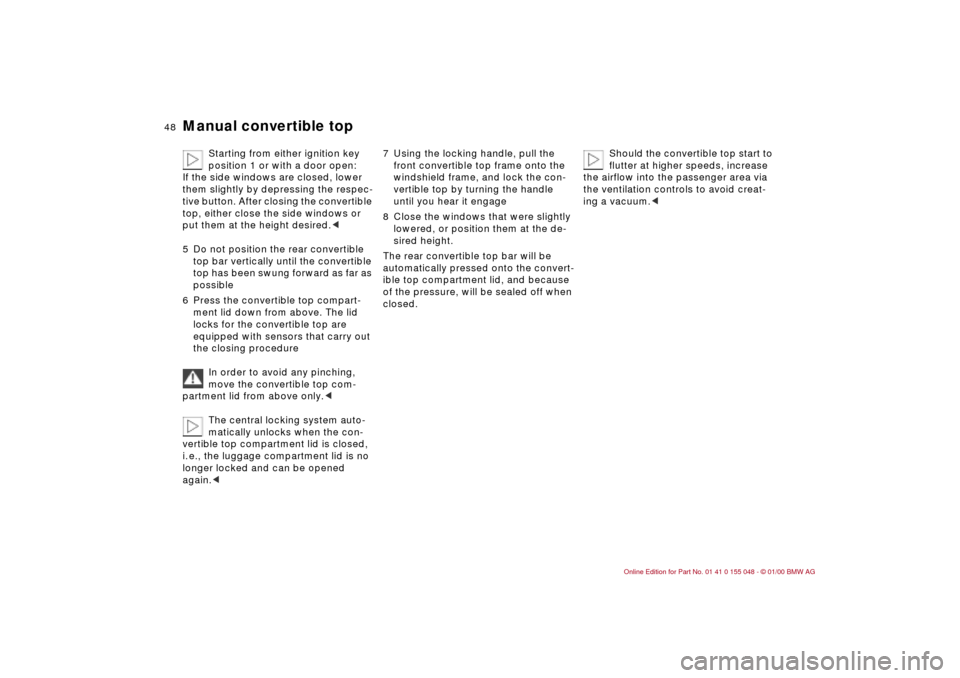
48n
Manual convertible top
Starting from either ignition key
position 1 or with a door open:
If the side windows are closed, lower
them slightly by depressing the respec-
tive button. After closing the convertible
top, either close the side windows or
put them at the height desired.c
5 Do not position the rear convertible
top bar vertically until the convertible
top has been swung forward as far as
possible
6 Press the convertible top compart-
ment lid down from above. The lid
locks for the convertible top are
equipped with sensors that carry out
the closing procedure
In order to avoid any pinching,
move the convertible top com-
partment lid from above only.c
The central locking system auto-
matically unlocks when the con-
vertible top compartment lid is closed,
i. e., the luggage compartment lid is no
longer locked and can be opened
again.c
7 Using the locking handle, pull the
front convertible top frame onto the
windshield frame, and lock the con-
vertible top by turning the handle
until you hear it engage
8 Close the windows that were slightly
lowered, or position them at the de-
sired height.
The rear convertible top bar will be
automatically pressed onto the convert-
ible top compartment lid, and because
of the pressure, will be sealed off when
closed.Should the convertible top start to
flutter at higher speeds, increase
the airflow into the passenger area via
the ventilation controls to avoid creat-
ing a vacuum.c
Page 50 of 199
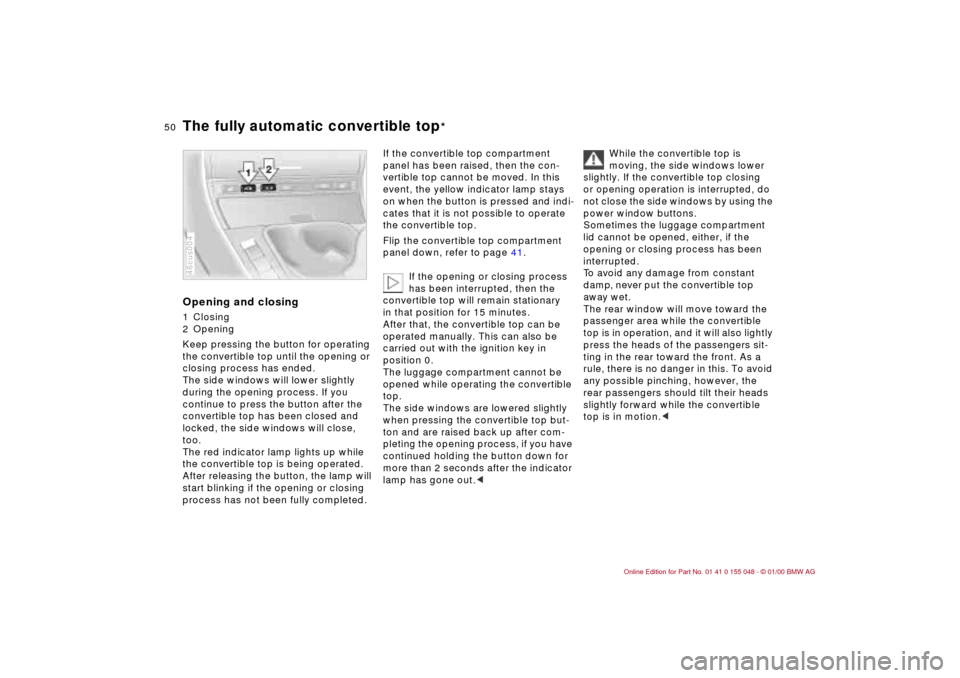
50n
The fully automatic convertible top
*
Opening and closing1 Closing
2 Opening
Keep pressing the button for operating
the convertible top until the opening or
closing process has ended.
The side windows will lower slightly
during the opening process. If you
continue to press the button after the
convertible top has been closed and
locked, the side windows will close,
too.
The red indicator lamp lights up while
the convertible top is being operated.
After releasing the button, the lamp will
start blinking if the opening or closing
process has not been fully completed.46cus004
If the convertible top compartment
panel has been raised, then the con-
vertible top cannot be moved. In this
event, the yellow indicator lamp stays
on when the button is pressed and indi-
cates that it is not possible to operate
the convertible top.
Flip the convertible top compartment
panel down, refer to page 41.
If the opening or closing process
has been interrupted, then the
convertible top will remain stationary
in that position for 15 minutes.
After that, the convertible top can be
operated manually. This can also be
carried out with the ignition key in
position 0.
The luggage compartment cannot be
opened while operating the convertible
top.
The side windows are lowered slightly
when pressing the convertible top but-
ton and are raised back up after com-
pleting the opening process, if you have
continued holding the button down for
more than 2 seconds after the indicator
lamp has gone out.c
While the convertible top is
moving, the side windows lower
slightly. If the convertible top closing
or opening operation is interrupted, do
not close the side windows by using the
power window buttons.
Sometimes the luggage compartment
lid cannot be opened, either, if the
opening or closing process has been
interrupted.
To avoid any damage from constant
damp, never put the convertible top
away wet.
The rear window will move toward the
passenger area while the convertible
top is in operation, and it will also lightly
press the heads of the passengers sit-
ting in the rear toward the front. As a
rule, there is no danger in this. To avoid
any possible pinching, however, the
rear passengers should tilt their heads
slightly forward while the convertible
top is in motion.c
Page 57 of 199
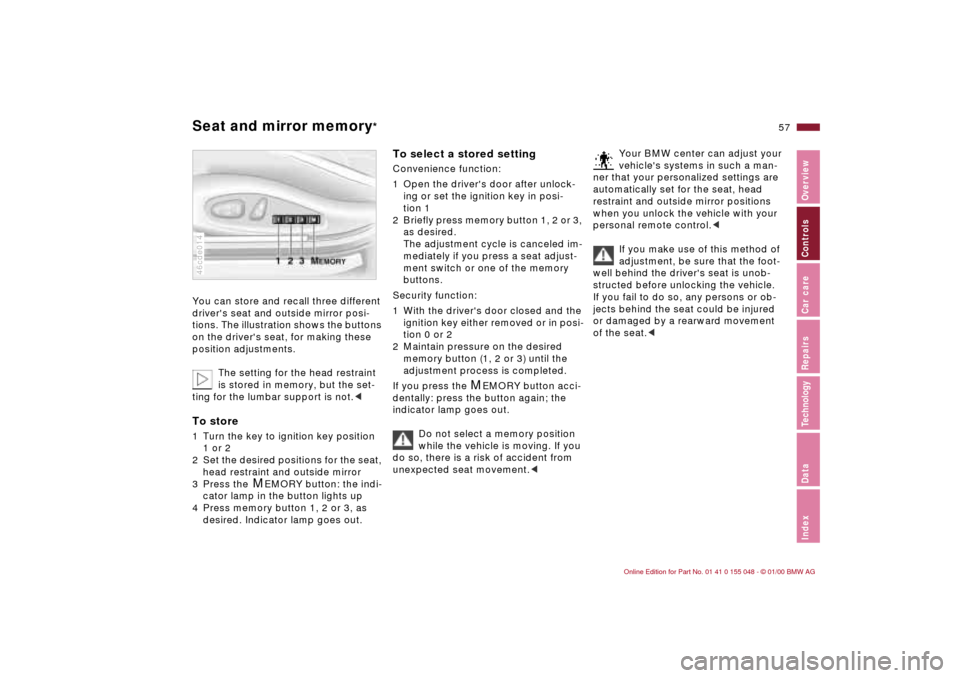
57n
IndexDataTechnologyRepairsCar careControlsOverview
Seat and mirror memory
*
You can store and recall three different
driver's seat and outside mirror posi-
tions. The illustration shows the buttons
on the driver's seat, for making these
position adjustments.
The setting for the head restraint
is stored in memory, but the set-
ting for the lumbar support is not.
2 Set the desired positions for the seat,
head restraint and outside mirror
3 Press the
M
EMORY button: the indi-
cator lamp in the button lights up
4 Press memory button 1, 2 or 3, as
desired. Indicator lamp goes out.
46cde014
To select a stored setting Convenience function:
1 Open the driver's door after unlock-
ing or set the ignition key in posi-
tion 1
2 Briefly press memory button 1, 2 or 3,
as desired.
The adjustment cycle is canceled im-
mediately if you press a seat adjust-
ment switch or one of the memory
buttons.
Security function:
1 With the driver's door closed and the
ignition key either removed or in posi-
tion 0 or 2
2 Maintain pressure on the desired
memory button (1, 2 or 3) until the
adjustment process is completed.
If you press the
M
EMORY button acci-
dentally: press the button again; the
indicator lamp goes out.
Do not select a memory position
while the vehicle is moving. If you
do so, there is a risk of accident from
unexpected seat movement.<
Your BMW center can adjust your
vehicle's systems in such a man-
ner that your personalized settings are
automatically set for the seat, head
restraint and outside mirror positions
when you unlock the vehicle with your
personal remote control.<
If you make use of this method of
adjustment, be sure that the foot-
well behind the driver's seat is unob-
structed before unlocking the vehicle.
If you fail to do so, any persons or ob-
jects behind the seat could be injured
or damaged by a rearward movement
of the seat.<
Page 59 of 199
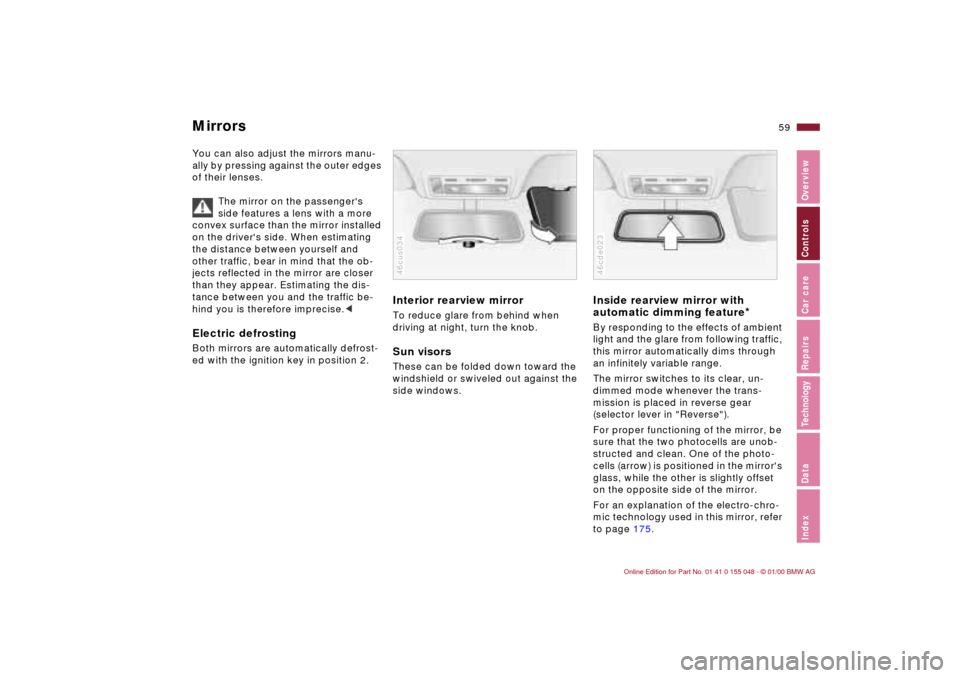
59n
IndexDataTechnologyRepairsCar careControlsOverview
MirrorsYou can also adjust the mirrors manu-
ally by pressing against the outer edges
of their lenses.
The mirror on the passenger's
side features a lens with a more
convex surface than the mirror installed
on the driver's side. When estimating
the distance between yourself and
other traffic, bear in mind that the ob-
jects reflected in the mirror are closer
than they appear. Estimating the dis-
tance between you and the traffic be-
hind you is therefore imprecise.
Interior rearview mirror To reduce glare from behind when
driving at night, turn the knob.Sun visorsThese can be folded down toward the
windshield or swiveled out against the
side windows.46cus034
Inside rearview mirror with
automatic dimming feature
*
By responding to the effects of ambient
light and the glare from following traffic,
this mirror automatically dims through
an infinitely variable range.
The mirror switches to its clear, un-
dimmed mode whenever the trans-
mission is placed in reverse gear
(selector lever in "Reverse").
For proper functioning of the mirror, be
sure that the two photocells are unob-
structed and clean. One of the photo-
cells (arrow) is positioned in the mirror's
glass, while the other is slightly offset
on the opposite side of the mirror.
For an explanation of the electro-chro-
mic technology used in this mirror, refer
to page 175.46cde023
Page 63 of 199
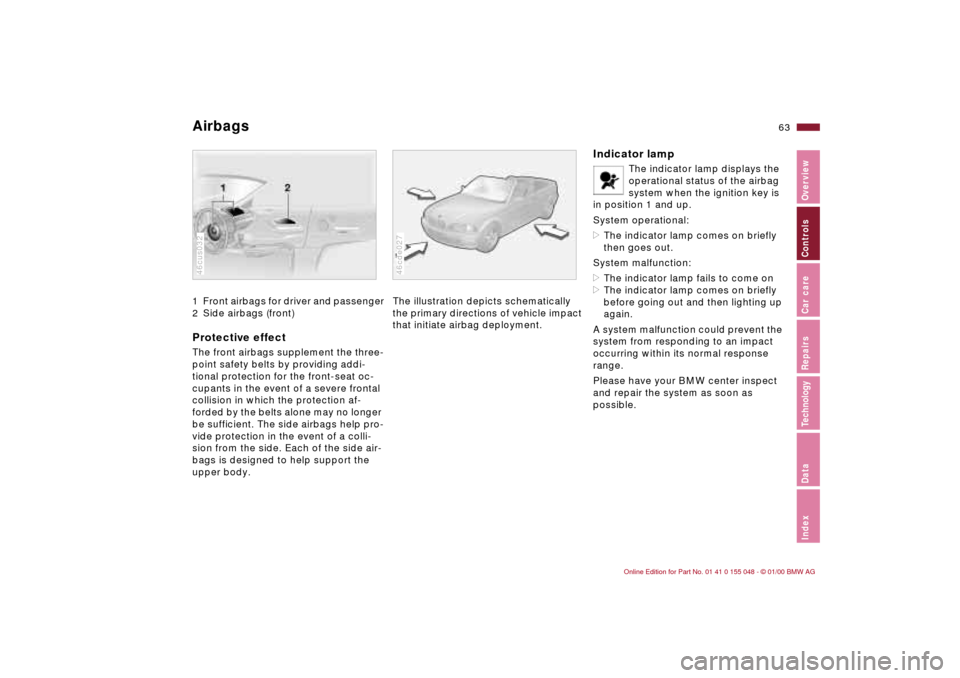
63n
IndexDataTechnologyRepairsCar careControlsOverview
Airbags 1 Front airbags for driver and passenger
2 Side airbags (front)Protective effectThe front airbags supplement the three-
point safety belts by providing addi-
tional protection for the front-seat oc-
cupants in the event of a severe frontal
collision in which the protection af-
forded by the belts alone may no longer
be sufficient. The side airbags help pro-
vide protection in the event of a colli-
sion from the side. Each of the side air-
bags is designed to help support the
upper body.46cus032
The illustration depicts schematically
the primary directions of vehicle impact
that initiate airbag deployment.46cde027
Indicator lamp
The indicator lamp displays the
operational status of the airbag
system when the ignition key is
in position 1 and up.
System operational:
>The indicator lamp comes on briefly
then goes out.
System malfunction:
>The indicator lamp fails to come on
>The indicator lamp comes on briefly
before going out and then lighting up
again.
A system malfunction could prevent the
system from responding to an impact
occurring within its normal response
range.
Please have your BMW center inspect
and repair the system as soon as
possible.
Page 65 of 199
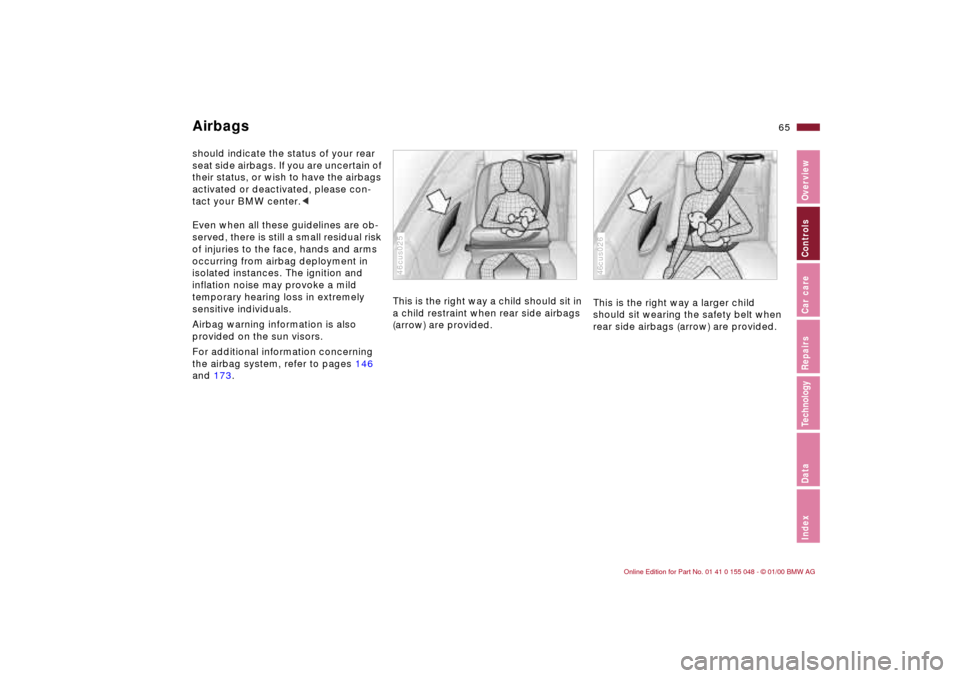
65n
IndexDataTechnologyRepairsCar careControlsOverview
Airbagsshould indicate the status of your rear
seat side airbags. If you are uncertain of
their status, or wish to have the airbags
activated or deactivated, please con-
tact your BMW center.<
Even when all these guidelines are ob-
served, there is still a small residual risk
of injuries to the face, hands and arms
occurring from airbag deployment in
isolated instances. The ignition and
inflation noise may provoke a mild
temporary hearing loss in extremely
sensitive individuals.
Airbag warning information is also
provided on the sun visors.
For additional information concerning
the airbag system, refer to pages 146
and 173.This is the right way a child should sit in
a child restraint when rear side airbags
(arrow) are provided.
46cus025
This is the right way a larger child
should sit wearing the safety belt when
rear side airbags (arrow) are provided.46cus026
Page 70 of 199
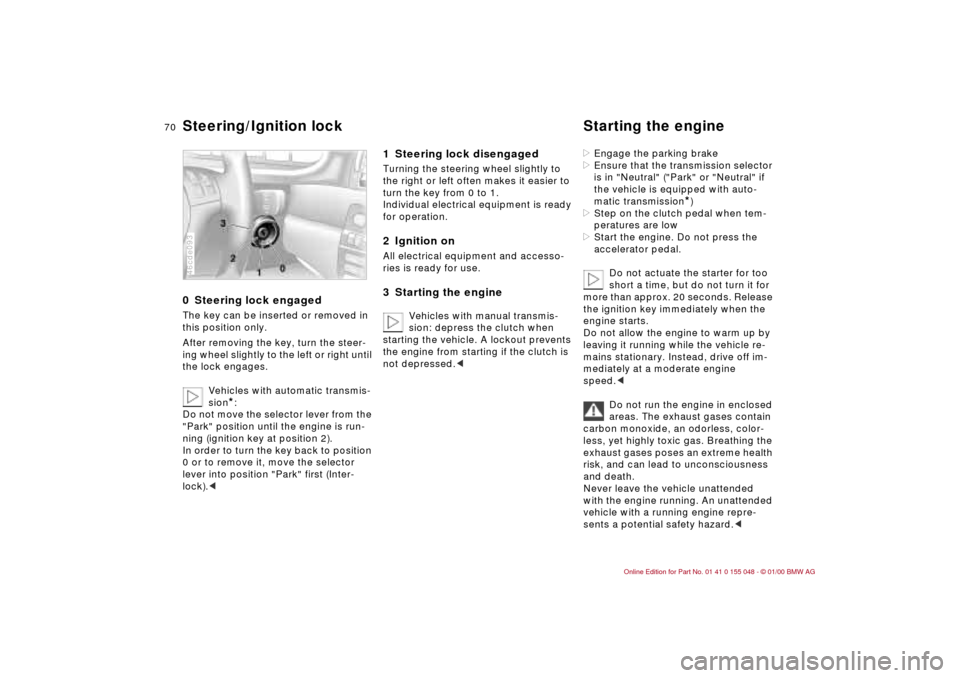
70n
0 Steering lock engaged The key can be inserted or removed in
this position only.
After removing the key, turn the steer-
ing wheel slightly to the left or right until
the lock engages.
Vehicles with automatic transmis-
sion
*:
Do not move the selector lever from the
"Park" position until the engine is run-
ning (ignition key at position 2).
In order to turn the key back to position
0 or to remove it, move the selector
lever into position "Park" first (Inter-
lock).<
46cde093
1 Steering lock disengaged Turning the steering wheel slightly to
the right or left often makes it easier to
turn the key from 0 to 1.
Individual electrical equipment is ready
for operation.2 Ignition onAll electrical equipment and accesso-
ries is ready for use.3 Starting the engine
Vehicles with manual transmis-
sion: depress the clutch when
starting the vehicle. A lockout prevents
the engine from starting if the clutch is
not depressed.<
>Engage the parking brake
>Ensure that the transmission selector
is in "Neutral" ("Park" or "Neutral" if
the vehicle is equipped with auto-
matic transmission
*)
>Step on the clutch pedal when tem-
peratures are low
>Start the engine. Do not press the
accelerator pedal.
Do not actuate the starter for too
short a time, but do not turn it for
more than approx. 20 seconds. Release
the ignition key immediately when the
engine starts.
Do not allow the engine to warm up by
leaving it running while the vehicle re-
mains stationary. Instead, drive off im-
mediately at a moderate engine
speed.<
Do not run the engine in enclosed
areas. The exhaust gases contain
carbon monoxide, an odorless, color-
less, yet highly toxic gas. Breathing the
exhaust gases poses an extreme health
risk, and can lead to unconsciousness
and death.
Never leave the vehicle unattended
with the engine running. An unattended
vehicle with a running engine repre-
sents a potential safety hazard.<
Steering/Ignition lock Starting the engine
Page 71 of 199

71n
IndexDataTechnologyRepairsCar careControlsOverview
Starting the engine Switching off the engine If the engine does not start on the first
attempt (if it is very hot or cold, for in-
stance):
>Press the accelerator pedal halfway
down while engaging the starter.
Cold start at extremely low tempera-
tures, from approx. +5 7 (–15 6)
and at elevations above 3,300 feet
(1,000 meters):
>On the first start attempt, engage the
starter for a longer period (approx.
10 seconds)
>Press the accelerator pedal halfway
down while engaging the starter.Turn the ignition key to position 1 or 0.
Do not remove the ignition key
while the vehicle is still moving. If
you did, the steering lock would engage
when the steering wheel is turned.
When you leave the vehicle, always re-
move the ignition key and engage the
steering lock.
Vehicles with manual transmission:
Always engage the parking brake when
parking on slopes and inclined sur-
faces, since placing the lever in 1st
gear or reverse may not provide ade-
quate resistance to rolling.
Vehicles with automatic transmission
*:
Place the selector lever in "Park".<
Page 72 of 199
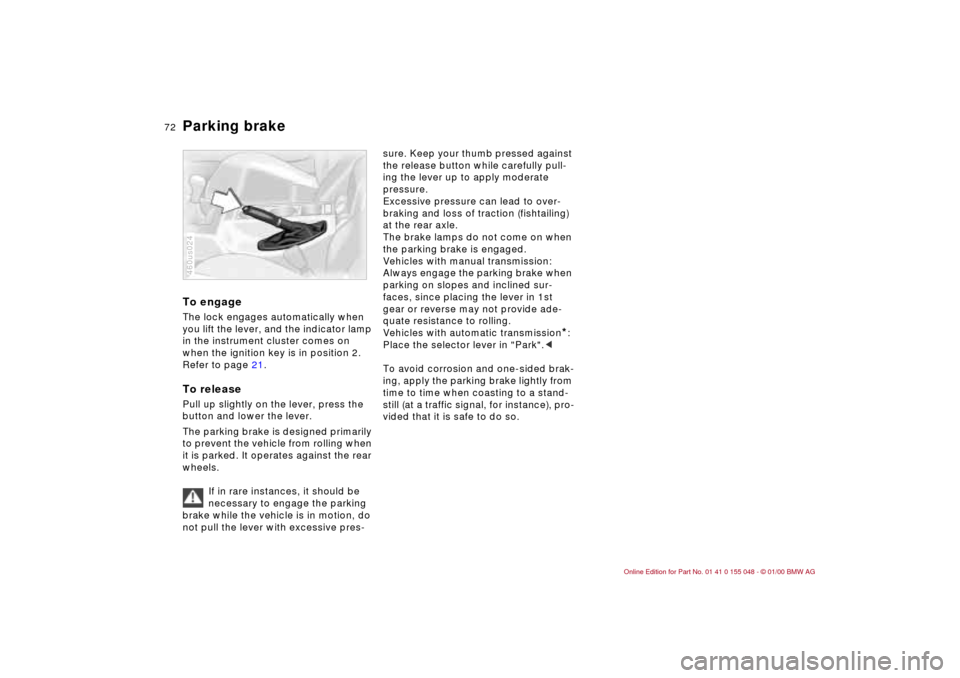
72n
Parking brake To engageThe lock engages automatically when
you lift the lever, and the indicator lamp
in the instrument cluster comes on
when the ignition key is in position 2.
Refer to page 21.To releasePull up slightly on the lever, press the
button and lower the lever.
The parking brake is designed primarily
to prevent the vehicle from rolling when
it is parked. It operates against the rear
wheels.
If in rare instances, it should be
necessary to engage the parking
brake while the vehicle is in motion, do
not pull the lever with excessive pres-460us024
sure. Keep your thumb pressed against
the release button while carefully pull-
ing the lever up to apply moderate
pressure.
Excessive pressure can lead to over-
braking and loss of traction (fishtailing)
at the rear axle.
The brake lamps do not come on when
the parking brake is engaged.
Vehicles with manual transmission:
Always engage the parking brake when
parking on slopes and inclined sur-
faces, since placing the lever in 1st
gear or reverse may not provide ade-
quate resistance to rolling.
Vehicles with automatic transmission
*:
Place the selector lever in "Park".<
To avoid corrosion and one-sided brak-
ing, apply the parking brake lightly from
time to time when coasting to a stand-
still (at a traffic signal, for instance), pro-
vided that it is safe to do so.
Page 73 of 199
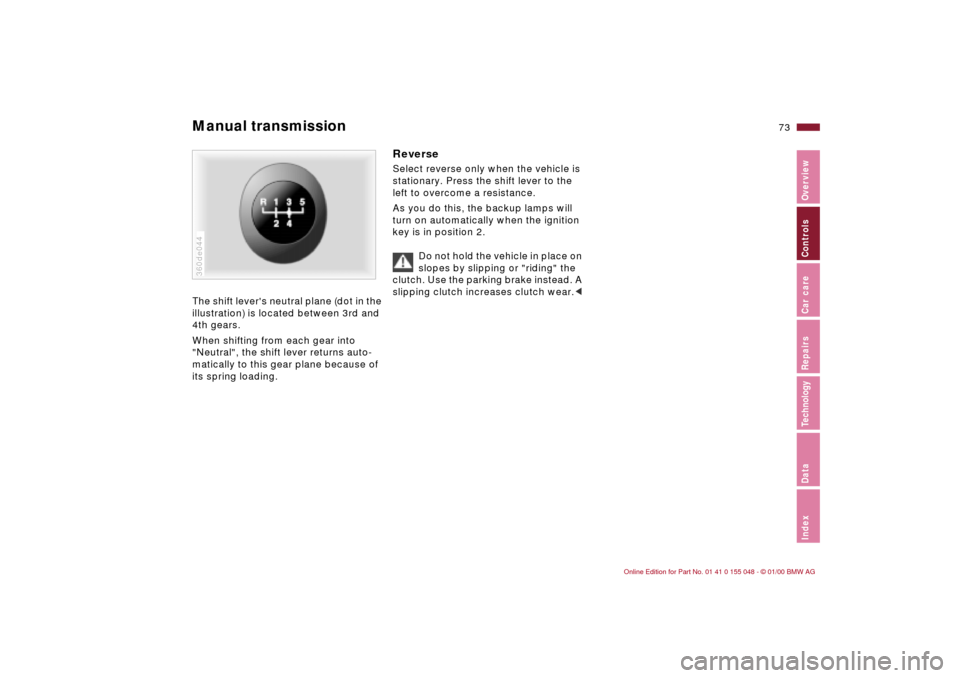
73n
IndexDataTechnologyRepairsCar careControlsOverview
Manual transmission The shift lever's neutral plane (dot in the
illustration) is located between 3rd and
4th gears.
When shifting from each gear into
"Neutral", the shift lever returns auto-
matically to this gear plane because of
its spring loading.360de044
Reverse Select reverse only when the vehicle is
stationary. Press the shift lever to the
left to overcome a resistance.
As you do this, the backup lamps will
turn on automatically when the ignition
key is in position 2.
Do not hold the vehicle in place on
slopes by slipping or "riding" the
clutch. Use the parking brake instead. A
slipping clutch increases clutch wear.<